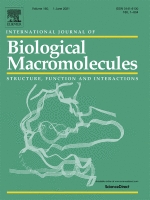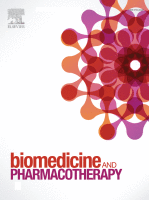Ferroptosis
How to submit an article:
- Registered users can submit any published journal article that has a unique DOI (Digital Object Identifier) name or link to Research Hub.
- For example, you can paste the full DOI link:
https://doi.org/10.1109/5.771073or just the DOI name:10.1109/5.771073into the field above and click submit. - The person who is first to submit a valid article to Research Hub will forever be credited for it, and every article submission earns you +6 Research Points.
Published research studies are articles that present the findings of original research that has undergone a peer-review process and has been made publicly available in scholarly journals, books or other media.

Tremella aurantialba polysaccharides alleviate ulcerative colitis in mice by improving intestinal barrier via modulating gut microbiota and inhibiting ferroptosis
2024 Nov International Journal of Biological Macromolecules Peng G, Wang S, Zhang H, Xie F, Jiao L, Yuan Y, et al.
Animal Study Gut Microbiota Ulcerative Colitis Intestinal Barrier Snow FungusThis article was submitted by Jinnan C. and is awaiting moderation..
A polysaccharide from Tremella aurantialba improves ulcerative colitis symptoms by targeting epithelial cell ferroptosis and modulating the gut microbiota.

Qi-Shen-Tang alleviates retinitis pigmentosa by inhibiting ferroptotic features via the NRF2/GPX4 signaling pathway
2023 Nov Heliyon Xiong M, Ou C, Yu C, Qiu J, Lu J, Fu C, et al.
Experimental Study Ferroptosis Qi Shen Tang Retinitis PigmentosaQi Shen Tang, a traditional Chinese medicine, was found to suppress retinal cell death in retinitis pigmentosa by inhibiting a process called ferroptosis.

Fructus Lycii and Salvia miltiorrhiza Bunge extract attenuate oxidative stress-induced photoreceptor ferroptosis in retinitis pigmentosa
2023 Nov Biomedicine & Pharmacotherapy Yang Y, Wang Y, Deng Y, Lu J, Xiao L, Li J, et al.
Experimental Study Goji Berry Dan Shen Retinitis PigmentosaFructus Lycii and Salvia miltiorrhiza Bunge extract (FSE) shows potential as a clinical treatment for retinitis pigmentosa by inhibiting photoreceptor cell death following oxidative stress.

Actinidia chinensis Planch prevents proliferation and migration of gastric cancer associated with apoptosis, ferroptosis activation and mesenchymal phenotype suppression
2020 Jun Biomedicine & Pharmacotherapy Gao Z, Deng G, Li Y, Huang H, Sun X, Shi H, et al.
In conclusion, Actinidia chinensis Planch (ACP) was a promising antineoplastic agent for the treatment of gastric cancer by regulating apoptosis, ferroptosis and mesenchymal phenotype.
Network Pharmacology Stomach CancerResearch insights are moderated by the Research Hub team and offer an at-a-glance overview of interesting research findings.

2024 International Journal of Biological Macromolecules
A polysaccharide from Tremella aurantialba improves ulcerative colitis symptoms by targeting epithelial cell ferroptosis and modulating the gut microbiota.
Animal Study Gut Microbiota Intestinal Barrier Snow Fungus Ulcerative Colitis
Tremella aurantialba polysaccharides alleviate ulcerative colitis in mice by improving intestinal barrier via modulating gut microbiota and inhibiting ferroptosis
Peng G, Wang S, Zhang H, Xie F, Jiao L, Yuan Y, et al.

2023 Heliyon
Qi Shen Tang, a traditional Chinese medicine, was found to suppress retinal cell death in retinitis pigmentosa by inhibiting a process called ferroptosis.
Experimental Study Qi Shen Tang Retinitis Pigmentosa
Qi-Shen-Tang alleviates retinitis pigmentosa by inhibiting ferroptotic features via the NRF2/GPX4 signaling pathway
Xiong M, Ou C, Yu C, Qiu J, Lu J, Fu C, et al.

2023 Biomedicine & Pharmacotherapy
Fructus Lycii and Salvia miltiorrhiza Bunge extract (FSE) shows potential as a clinical treatment for retinitis pigmentosa by inhibiting photoreceptor cell death following oxidative stress.
Experimental Study Dan Shen Goji Berry Retinitis Pigmentosa
Fructus Lycii and Salvia miltiorrhiza Bunge extract attenuate oxidative stress-induced photoreceptor ferroptosis in retinitis pigmentosa
Yang Y, Wang Y, Deng Y, Lu J, Xiao L, Li J, et al.
Review Articles
Review articles summarise and critically evaluate the current state of research on a specific topic or field by synthesising multiple primary research studies.
Clinical Trials
Clinical trials are research studies that involve people and are conducted to evaluate the safety and efficacy of new treatments or interventions, such as drugs, medical devices, or behavioural therapies.
Study Protocols
Published study protocols are detailed plans that outline the objectives, methodology, statistical analyses, and organisation of a research study that have been made publicly available for others to review and use as a reference.
Presentation Slides

Animal Study
A polysaccharide from Tremella aurantialba improves ulcerative colitis symptoms by targeting epithelial cell ferroptosis and modulating the gut microbiota.
Peng G, Wang S, Zhang H, Xie F, Jiao L, Yuan Y, Ma C, Wu H, Meng Z

Experimental Study
Qi Shen Tang, a traditional Chinese medicine, was found to suppress retinal cell death in retinitis pigmentosa by inhibiting a process called ferroptosis.
Xiong M, Ou C, Yu C, Qiu J, Lu J, Fu C, Peng Q, Zeng M, Song H

Experimental Study
Fructus Lycii and Salvia miltiorrhiza Bunge extract (FSE) shows potential as a clinical treatment for retinitis pigmentosa by inhibiting photoreceptor cell death following oxidative stress.
Yang Y, Wang Y, Deng Y, Lu J, Xiao L, Li J, Zhou Y, Nie F, Chen X, Peng J, Tan H, Qin Y, Peng Q
Executive Summary
Write an executive summary in the form of a blog article on the topic of "Research into Chinese medicine treatment for Ferroptosis" summarising the research below and using language that can be easily understood by patients and avoiding medical jargon using a professional and caring tone of voice.
Write an executive summary in the form of a blog article on the topic of "Researched Chinese medicine treatments for Ferroptosis" summarising the research below in an objective and easy to understand way, and using language that can be easily understood by patients. Group the article into Chinese medicine treatments first, followed by nutrition and other treatments. Avoid using medical jargon and use a professional and caring tone of voice.
Write me a concise but easy to understand executive summary on the topic of "Chinese medicine treatments for Ferroptosis" based on the following research that I will give you. Your summary should be 2 paragraphs long in Australian English spelling and include references to the studies.
A Animal Study published in 2024 in the journal International Journal of Biological Macromolecules found that A polysaccharide from Tremella aurantialba improves ulcerative colitis symptoms by targeting epithelial cell ferroptosis and modulating the gut microbiota. The methodology used in this research involved isolating TA 2-1, a specific polysaccharide from Tremella Aurantialba, and studying its effects on ulcerative colitis. This was done by introducing it to Caco-2 cells that were undergoing ferroptosis and assessing its impact on cell viability. The influence of TA 2-1 was also examined in mice with artificially induced ulcerative colitis, verifying its ameliorating effects in an in-vivo context. The structure of TA 2-1 and its components were analysed and the polysaccharide's interaction with gut microbiota was explored to understand how it might modulate symptoms or prevent cell death. The results of this study showed that TA 2-1 does not only decrease the rate of cell death in epithelial cells undergoing ferroptosis, but it also repairs the intestinal barrier by upregulating specific proteins such as claudin-1 and zonula occludens-1. TA 2-1 was also found to suppress lipid peroxidation, thus inhibiting ferroptosis. Further investigation revealed that TA 2-1 may alleviate ulcerative colitis by influencing the composition or metabolites of gut microbiota. This research offers promising insight into the potential of TA 2-1 in treating ulcerative colitis.
A Experimental Study published in 2023 in the journal Heliyon found that Qi Shen Tang, a traditional Chinese medicine, was found to suppress retinal cell death in retinitis pigmentosa by inhibiting a process called ferroptosis. The researchers investigated the potential mechanism of Qi-Shen-Tang (QST), a combination of two traditional Chinese medicines, on retinitis pigmentosa, an eye disease. They induced a retinitis pigmentosa model in mice while subsequently treating them with QST. They then examined the impact of the medicine on the tissue morphology and function of the retina in these model mice, in addition to monitoring factors such as retinal blood flow and fundus structure. The study found that the treatment with QST led to notable improvements in the retinal tissue morphology and function. In addition, they observed an increase in retinal blood flow and normalization of the fundus structure. Following the treatment, the amounts of iron and malondialdehyde in the retinal tissue were significantly reduced, while the levels of superoxide dismutase, glutathione, and the protein expressions of various enzymes significantly increased. Molecular docking results also revealed potential interactions between the components of QST and key proteins of a particular signaling pathway, namely the Nuclear factor erythroid 2-related factor 2/ Glutathione peroxidase 4 pathway. The results suggest that QST may inhibit ferroptosis by suppressing this signaling pathway, thereby mitigating retinitis pigmentosa-induced damage to the retinal tissue.
A Experimental Study published in 2023 in the journal Biomedicine & Pharmacotherapy found that Fructus Lycii and Salvia miltiorrhiza Bunge extract (FSE) shows potential as a clinical treatment for retinitis pigmentosa by inhibiting photoreceptor cell death following oxidative stress. The study utilized hydrogen peroxide to induce oxidative stress in 661 W cells, which were examined with flow cytometry and an enzyme-linked immunosorbent assay. The impact of this oxidative stress on the cells’ mitochondria was observed using an electron microscope to understand the nature of cell death. The study also analyzed the compensatory effect of the Fructus Lycii and Salvia miltiorrhiza Bunge extract on the retinal structure and function of rd10 mice using histopathological examination, fundus photographs, and electroretinography. Protein levels were evaluated using Western blot assays, specifically targeting proteins including Tumor Protein p53, Solute Carrier Family 7 Member 11, Glutathione peroxidase 4, Arachidonate-12-Lipoxygenase, and Dipeptidyl peptidase 4. The results showed that hydrogen peroxide-induced oxidative stress in 661 W cells increased oxidative stress products and certain protein expressions, while decreasing others. Notably, the activation of Glutathione peroxidase 4 did not lessen reactive oxygen species generation and had little impact on cell death. The research discovered that both Ferrostatin-1 and the extract could lessen reactive oxygen species generation and inhibit cell death of photoreceptors in retinitis pigmentosa, achieving this by inhibiting the expression of one protein and increasing the expression of two others.
Moderation Tools
Topic
Sign In
Users not signed in are limited to viewing the 5 most recent items of content.